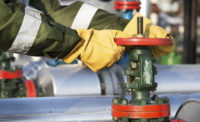There are many hazards that can occur during oil and gas extraction activities. A few of the most common hazards, according to OSHA, are detailed below:
Vehicle collisions: Workers and equipment are required to be transported to and from well sites. Wells are often located in remote areas, and require traveling long distances to get to the sites. Highway vehicle crashes are the leading cause of oil and gas extraction worker fatalities. Roughly four of every 10 workers killed on the job in this industry are killed as a result of a highway vehicle incident, according to the Census of Fatal Occupational Injuries.
Struck-by/ caught-in/ caught-between: Three of every five on-site fatalities in the oil and gas extraction industry are the result of struck-by/caught -in/caught-between hazards, according to OSHA. Workers might be exposed to struck-by/caught-in/caught-between hazards from multiple sources, including moving vehicles or equipment, falling equipment, and high-pressure lines.
Explosions and fires: Workers in the oil and gas industries face the risk of fire and explosion due to ignition of flammable vapors or gases. Flammable gases, such as well gases, vapors and hydrogen sulfide, can be released from wells, trucks, production equipment or surface equipment such as tanks and shale shakers. Ignition sources can include static, electrical energy sources, open flames, lightning, cigarettes, cutting and welding tools, hot surfaces and frictional heat.
Falls: Workers might be required to access platforms and equipment located high above the ground. OSHA requires fall protection to prevent falls from the mast, drilling platform, and other elevated equipment.
Confined spaces: Workers are often required to enter confined spaces such as petroleum and other storage tanks, mud pits, reserve pits and other excavated areas, sand storage containers and other confined spaces around a wellhead. Safety hazards associated with confined space include ignition of flammable vapors or gases. Health hazards include asphyxiation and exposure to hazardous chemicals. Confined spaces that contain or have the potential to contain a serious atmospheric hazard must be classified as permit-required confined spaces, tested prior to entry and continuously monitored.
Electrical and other hazardous energy: Workers might be exposed to uncontrolled electrical, mechanical, hydraulic or other sources of hazardous energy if equipment is not designed, installed and maintained properly. Also, administrative controls such as operating procedures must be developed and implemented to ensure safe operations.
OSHA offers the following tips for planning and prevention:
- Know the hazards. Evaluate the hazards at the worksite. Many companies within the oil and gas industry use the Job Safety Analysis process (also referred to as a JSA, Job Hazard Analysis, or JHA) to identify hazards and find solutions.
- Establish ways to protect workers, including developing and implementing safe practices for:
- Confined space; excavations
- Chemical handling; exposure
- Chemical storage
- Electrical work
- Emergency response
- Equipment/machine hazards
- Fall protection
- Fire protection
- Hot work, welding, flame cutting operations
- Personal protective equipment use
- Power sources (lockout/tagout provisions, safe distance from power lines)
- Working in the heat, long shifts
- Provide personal protective equipment (PPE). When engineering controls alone cannot protect worker overexposure to chemicals, noise, or other hazards, the employer must provide PPE.
- Communicate the hazards, and train workers.
-
Have a plan for contractor safety and training.





